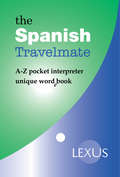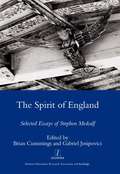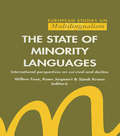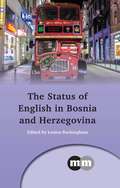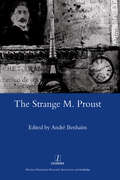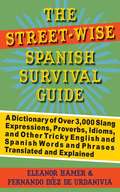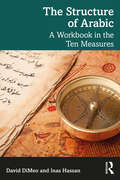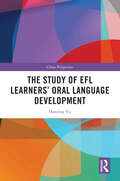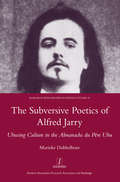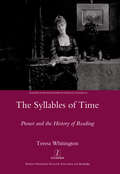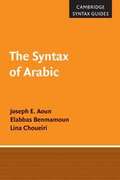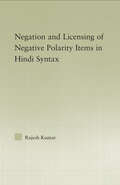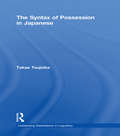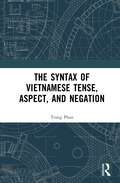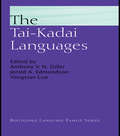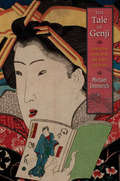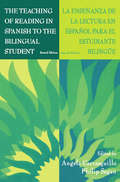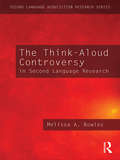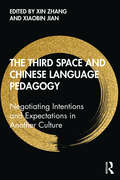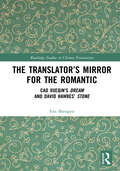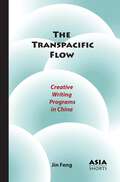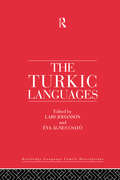- Table View
- List View
The Spanish Travelmate
by Lexus Alicia de Benito Harland Mike HarlandThe Spanish Travelmate phrasebook and dictionary gives you a detailed yet easy-to-use A to Z list of English words and phrases with Spanish translations for quick-find reference. There are more than 3500 words and phrases, and the Spanish translations come together with an easy-to-read pronunciation guide. Tap a hyperlink (there are hundreds of them) to go to special sections: travel tips about being in Spain; basic language notes; typical Spanish replies to your Spanish questions; conversion tables. These are features which make the Travelmate the must-have ebook Spanish phrasebook download for the traveller who wants to really communicate. The Spanish Travelmate phrasebook and dictionary also gives you a detailed Spanish menu reader of over 500 items and a dictionary section with translations of over 300 common Spanish signs and notices. This is the little book that's a big help. And a joined-up language experience.
The Spirit of England: Selected Essays of Stephen Medcalf
by Stephen MedcalfStephen Medcalf (1937-2006) was an essayist, in the best traditional sense of that calling: a writer not of books but of substantial and justly celebrated essays, widely read in the Times Literary Supplement and elsewhere. Medcalf's abiding question to the world was the Psalmist's: 'What is man that thou art mindful of him?' His was a Blakean sense of Englishness, far from the chocolate-box painting or the television adaptation, and for him the strongest writers were those keenly aware of their roots in the classical, Anglo-Saxon or Celtic past. By gathering together Medcalf's most important work, this volume shows the coherence of his thinking, and of the elusive, complicated literary heritage he celebrated, one which acknowledges the Greco-Roman strain, the Christian strain, the down-to-earth humour and the sly irony. Thirteen substantial essays cover Virgil, the Bible, the English translation of Alfred, Piers Plowman, the 'half-alien culture' of the high Middle Ages, Chaucer's contemporary Thomas Usk, Shakespeare's images of resurrection, Horace and Kipling juxtaposed, G. K. Chesterton, T. S. Eliot's use of Ovid, P. G. Wodehouse, William Golding, John Betjeman, Geoffrey Hill and other writers. The book concludes with perhaps Medcalf's most personal article of all: his account of finding a baby in a phone box on a cold winter's night, which first appeared in the Guardian Christmas Supplement in 2002.
The State of Minority Languages
by Sjaak KroonMany regional languages across the world are threatened by modernization and urbanization whilst the universal and rapid rise of migration has created new and unprecedented forms of multilingualism. Aspects of education, national policies and attitudes towards minority languages are documented.
The Status of English in Bosnia and Herzegovina
by Louisa BuckinghamWhen Yugoslavia disintegrated in the early 1990s, competence in English was not widespread. This book explores how English came to be equated with economic survival for many during and after the ensuing war through a range of diverse social and professional contexts, from the classroom to the military to the International Criminal Court. While English provided social mobility for many, its abrupt arrival also contributed to the marginalization of those without the adequate language skills. The high level of international intervention in Bosnia and Herzegovina over the last two decades has contributed to a sense of normalization of the presence of English. Viewed as a far more complex issue than simple linguistic imposition, this book explores the widespread adoption of English and its effects on a nation recovering from war.
The Strange M. Proust
by Andre BenhaimThe strange M. Proust - the narrator, the author, and the embodiment of A la Recherche du Temps perdu - is now so canonical a writer that his very strangeness is easily overlooked. His book made of other books, his epic composed of extraordinary miniatures, his orderly structure where every law is subverted, his chronology where time can be undone and his geography where places can superimpose: in these, and many other ways, Proust continues to astonish even readers who have engaged with him for their entire careers. In this book, arising from the Princeton symposium of 2006, major critics come together to offer provocative readings of a work which is at the same time classical and unusual, French and foreign, familiar and strange. The book is dedicated to the memory of Malcolm Bowie (1943-2007), whose keynote address was one of his last major lectures. Other contributors include David Ellison, Anne Simon, Eugene Nicole, Joseph Brami, Raymonde Coudert, Christie McDonald, Michael Wood and Antoine Compagnon.
The Street-Wise Spanish Survival Guide: A Dictionary of Over 3,000 Slang Expressions, Proverbs, Idioms, and Other Tricky English and Spanish Words and Phrases Translated and Explained
by Eleanor Hamer Fernando Díez de UrdaniviaIf you were dropped into the middle of Managua, Mexico City, or Miami, would you know how to speak not only the language, but also the lingo? In The Street-Wise Spanish Survival Guide, the reader who is already familiar with Spanish will discover the banter and metaphor (both polite and rude) that enrich the spoken language as it is really used, hints on avoiding embarrassing mistakes in grammar, and a list of dreaded false cognates. Full of advice on pronunciation and tips on customs and manners, and keyed with time-saving symbols, this is the best guide available to understanding and appreciating Spanish as it is spoken in Latin America and the United States.
The Structure of Arabic: A Workbook in the Ten Measures
by David DiMeo Inas HassanThe Structure of Arabic: A Workbook in the Ten Measures is a comprehensive guide and workbook in the ten measures of Arabic words, the backbone of the Arabic lexical system, and provides a systematic explanation of the root and pattern system that forms the basis of most Arabic words. Successful Arabic learners have long recognized mastery of these measures and patterns as key to understand the Arabic language. With knowledge of this system, learners will be able to predict the meaning of unfamiliar words, recognize the function of words, and understand correct pronunciation of Arabic words, making vocabulary acquisition and retention easier. This unique textbook introduces measures and patterns sequentially across ten chapters, helping learners to navigate the topics in a logical manner. Without complicated jargon or technical language, this easy-to-understand textbook demystifies key topics in Arabic grammar. Comparative sentences which encapsulate the differences between measures give context, and exercises within the chapters serve to consolidate the learners’ grasp of the material presented.Designed to supplement both class-based Arabic courses and independent study, The Structure of Arabic will help learners of Arabic at all levels of competency to improve their vocabulary, pronunciation, spelling, and comprehension.
The Structure of Spoken Language
by Philippe MartinUsing an innovative approach, this book focuses on a widely debated area of phonetics and phonology: intonation, and specifically its relation to metrics, its interface with syntax, and whether it can be attributed more to phonetics or phonology, or equally to both. Drawing on data from six Romance languages (French, Italian, Spanish, Portuguese, Catalan and Romanian), whose rich intonation patterns have long been of interest to linguists, J-Philippe Martin challenges the assumptions of traditional phonological approaches, and re-evaluates the data in favour of a new usage-based model of intonation. He proposes a unified description of the sentence prosodic structure, focusing on the dynamic and cognitive aspects of both production and perception of intonation in speech, leading to a unified grammar of Romance languages' sentence intonation. This book will be welcomed by researchers and advanced students in phonetics and phonology.
The Students We Share: Preparing US and Mexican Educators for Our Transnational Future
by Patricia Gándara; Bryant JensenMillions of students in the US and Mexico begin their educations in one country and find themselves trying to integrate into the school system of the other. As global migration increases, their numbers are expected to grow and more and more teachers will find these transnational students in their classrooms. The goal of The Students We Share is to prepare educators for this present and future reality. While the US has been developing English as a Second Language programs for decades, Mexican schools do not offer such programs in Spanish and neither the US nor Mexico has prepared its teachers to address the educational, social-psychological, or other personal needs of transnational students. Teachers know little about the circumstances of transnational students' lives or histories and have little to no knowledge of the school systems of the country from which they or their family come. As such, they are fundamentally unprepared to equitably educate the "students we share," who often fall through the cracks and end their educations prematurely. Written by both Mexican and US pioneers in the field, chapters in this volume aim to prepare educators on both sides of the US-Mexico border to better understand the circumstances, strengths, and needs of the transnational students we teach. With recommendations for policymakers, administrators, teacher educators, teachers, and researchers in both countries, The Students We Share shows how preparing teachers is our shared responsibility and opportunity. It describes policies, classroom practices, and norms of both systems, as well as examples of ongoing partnerships across borders to prepare the teachers we need for our shared students to thrive.
The Study of EFL Learners’ Oral Language Development (China Perspectives)
by Hanjing YuThe book provides a systematic investigation of the dynamic trajectories in the oral language development of English as a foreign language (EFL) learners, integrating both inter-individual variation and intra-individual variability. It also identifies unobserved heterogeneity in oral language production.Using longitudinal designs, comprehensive developmental data collection, and innovative analytic techniques, the study reveals distinct developmental trajectories in the oral language systems of EFL learners. It also examines the interactions among complexity, accuracy, and fluency (CAF), exploring the potential of complex dynamic systems theory (CDST)-inspired approaches to studying oral language development and their implications for teaching oral language to Chinese learners. In addition, by employing the novel growth mixture model (GMM) method, the study identifies salient developmental patterns of CAF within a larger population, thereby contributing to the generalizability of findings from CDST-based language development research.This book will be valuable to students, researchers, and educational practitioners interested in oral language development and complex dynamic systems theory.
The Subversive Poetics of Alfred Jarry: Ubusing Culture in the Almanachs Du Pere Ubu
by Marieke DubbelboerParadox and provocation were essential features of all of the work of Alfred Jarry (1873-1907). His non-conformist attitude, whether employed to subvert literary or artistic conventions or to scrutinize social and political issues, marked both his literary writing and his view of the world. Nowhere is this more apparent than in the experimental and satirical Almanachs du Pere Ubu (1898 and 1901), which to date have received little critical attention. Jarry's groundbreaking use of collage in these early works, his absurdist humour and his rethinking of literary authorship and artistic originality foreshadow many innovations of twentieth-century art and literature. In this generously illustrated study Marieke Dubbelboer examines key characteristics of Jarry's poetics through an analysis of the Almanachs and addresses their role within the European avant-garde.
The Syllables of Time: Proust and the History of Reading
by Teresa WhitingtonThis study reveals reading to be one of the main activities to occupy the inhabitants of the world of Marcel Prousts novel A la recherche du temps perdu. Characters do not just read books but have access to the journals and newspapers of a rapidly expanding print industry. They receive letters and postcards from family and friends. The posters of a nascent advertising industry tempt them to spend an evening at the theatre or a holiday by the sea, and new forms of communication, such as telegraphy, enter their lives and require new strategies of deciphering. All human activity is glossed by means of a series of metaphors of reading, extending the readers domain beyond the written text. Through a series of illuminating analyses, Teresa Whitington shows how this web of references builds into a specifically Proustian account of both the outer, social context of reading and the inner, psychological world of the reader. Proust offers a contribution to the history of reading in the France of his own lifetime and suggests that reading is the very condition of the writing of his fiction.
The Syntactic Structures of Korean
by Jong-Bok KimCovering both core and peripheral phenomena, The Syntactic Structures of Korean is a concrete and precise grammar of the language. Based on the framework of Sign-based Construction Grammar, it provides a grammar of Korean which is computationally implementable and cognitively viable. Remarkably broad, yet in-depth, it is an outstanding analysis of Korean syntax and semantics which will be welcomed by those working in linguistics and the Korean language.
The Syntax of Arabic
by Joseph E. Aoun Elabbas Benmamoun Lina ChoueiriRecent research on the syntax of Arabic has produced valuable literature on the major syntactic phenomena found in the language. This guide to Arabic syntax provides an overview of the major syntactic constructions in Arabic that have featured in recent linguistic debates, and discusses the analyses provided for them in the literature. A broad variety of topics are covered, including argument structure, negation, tense, agreement phenomena, and resumption. The discussion of each topic sums up the key research results and provides new points of departure for further research. The book also contrasts Standard Arabic with other Arabic varieties spoken in the Arab world. An engaging guide to Arabic syntax, this book will be invaluable to graduate students interested in Arabic grammar, as well as syntactic theorists and typologists.
The Syntax of Negation and the Licensing of Negative Polarity Items in Hindi (Outstanding Dissertations in Linguistics)
by Rajesh KumarThis books studies syntax of NPIs and their interaction with sentential negatives in Hindi. It outlines the clause structure of Hindi and locates the syntactic position of sentential negatives as well as constituent negatives within the structure. It is argued that sentential negative in Hindi negation marker heads its own maximal projection, NegP, which is immediately dominated by TP. In addition to locating the position of negation markers in the clause structure, it outlines the distribution of negative polarity items (NPIs) in Hindi and the structural constraints on their licensing by sentential negative. The book argues that an NPI in Hindi is licensed overtly in the course of derivation by a c-commanding negative marker. The bulk of the evidence presented in this book argues against previous theoretical accounts that claim that NPI licensing involves covert syntactic operations such as LF movement or reconstruction. With respect to the classification of NPIs , this book also shows the existence of two different types of NPIs in Hindi; namely, strong NPIs and weak NPIs. Strong NPIs require a clause mate c-commanding negative licensor, whereas weak NPIs are quantifiers and are similar to free choice 'any' in English that are interpreted as NPIs in the presence of a c-commanding negative licensor.
The Syntax of Possession in Japanese (Outstanding Dissertations in Linguistics)
by Takae TsujiokaFirst Published in 2002. Routledge is an imprint of Taylor & Francis, an informa company.
The Syntax of Vietnamese Tense, Aspect, and Negation
by Trang PhanThe Syntax of Vietnamese Tense, Aspect, and Negation investigates familiar grammatical phenomena including Tense, Aspect, and Negation in a theoretically understudied language, Vietnamese. The purpose of this book is to thoroughly examine how these categories are realised and how they interact with one another in Vietnamese in the spirit of Generative Grammar, in particular, the Cartographic approach to syntax and its most recently developed lexicalisation technique, Nanosyntax. It is concluded that despite lacking inflectional tense, Vietnamese does have syntactic tense, i.e., Vietnamese has those structural positions which are dedicated to Tense and Aspect. In fact, Tense and Aspect in Vietnamese are realised via a rigid fine-grained functional sequence which syntacticises subtle semantic distinctions both preverbally and post-verbally. There is a two-way complicated relationship between Negation and Aspect in Vietnamese, which can be explained in a principled way by taking into consideration how the internal syntax of the temporal, aspectual, and negative markers derives their clausal syntax. This book also discusses how Vietnamese Tense, Aspect, and Negation pattern with, and differ from, their counterparts in Western Indo-European languages, and how this study contributes to a better understanding of East and mainland Southeast Asian languages more generally, as well as of language universally. This book will be of interest to both undergraduate and postgraduate students of contemporary linguistics, and for scholars interested in contemporary approaches to Vietnamese linguistics, and Southeast Asian languages more generally.
The Tai-Kadai Languages (Routledge Language Family Series)
by Anthony Diller Jerry Edmondson Yongxian LuoThe Routledge Language Family Series is aimed at undergraduates and postgraduates of linguistics and language, or those with an interest in historical linguistics, linguistics anthropology and language development. With close to 100 million speakers, Tai-Kadai constitutes one of the world's major language families. The Tai-Kadai Languages provides a unique, comprehensive, single-volume tome covering much needed grammatical descriptions in the area. It presents an important overview of Thai that includes extensive cross-referencing to other sections of the volume and sign-posting to sources in the bibliography. The volume also includes much new material on Lao and other Tai-Kadai languages, several of which are described here for the first time. Much-needed and highly useful, The Tai-Kadai Languages is a key work for professionals and students in linguistics, as well as anthropologists and area studies specialists. ANTHONY V. N. DILLER is Foundation Director of the National Thai Studies Centre, at the Australian National University. JEROLD A. EDMONDSON is Professor of Linguistics at the University of Texas Arlington and a member of the Academy of Distinguished Scholars. YONGXIAN LUO is Senior Lecturer in the Asia Institute at the University of Melbourne and a member of the Australian Linguistic Society.
The Tale of Genji: Translation, Canonization, and World Literature (Tuttle Classics)
by Michael EmmerichMichael Emmerich thoroughly revises the conventional narrative of the early modern and modern history of The Tale of Genji. Exploring iterations of the work from the 1830s to the 1950s, he demonstrates how translations and the global circulation of discourse they inspired turned The Tale of Genji into a widely read classic, reframing our understanding of its significance and influence and of the processes that have canonized the text.Emmerich begins with an analysis of the lavishly produced best seller Nise Murasaki inaka Genji (A Fraudulent Murasaki's Bumpkin Genji, 1829–1842), an adaptation of Genji written and designed by Ryutei Tanehiko, with pictures by the great print artist Utagawa Kunisada. He argues that this work introduced Genji to a popular Japanese audience and created a new mode of reading. He then considers movable-type editions of Inaka Genji from 1888 to 1928, connecting trends in print technology and publishing to larger developments in national literature and showing how the one-time best seller became obsolete. The study subsequently traces Genji's reemergence as a classic on a global scale, following its acceptance into the canon of world literature before the text gained popularity in Japan. It concludes with Genji's becoming a "national classic" during World War II and reviews an important postwar challenge to reading the work after it attained this status. Through his sustained critique, Emmerich upends scholarship on Japan's preeminent classic while remaking theories of world literature, continuity, and community.
The Teaching of Reading in Spanish to the Bilingual Student: La Ense¤anza De La Lectura En Espa¤ol Para El Estudiante Biling e
by Angela Carrasquillo Philip SeganThis dual-language text provides theory and methodology for teaching reading in Spanish to Spanish/English bilingual or Spanish-dominant students. The goal is to help educators teach these students the skills necessary to become proficient readers and, thus, successful in the school system. At the very core of the book are the hispano-parlantes--the Spanish-speaking children--who bring to the schools, along with their native language and cultures, a wealth of resources that must be tapped and to whom all educators have a responsibility to respond. True to the concepts of developing bilingual educators to serve bilingual students, the text presents chapters in English and Spanish. Each chapter is written in only one language at the preference of the author. Thus, to be successful with this book, the reader must be bilingual. Themes emphasized in the text include current reading methodologies, the concept of reading as developmental literacy skills, reading in the content areas, new views of the development of proficiency in the second language, issues related to students with special learning needs, assessment, and the uses of technology in the delivery of instruction. Never losing sight of its goal--to teach reading in Spanish to bilingual or Spanish-dominant students--the book includes a series of focusing questions and follow-up activities; these are not simply translations of existing activities, strategies, and techniques intended for monolingual English students, but specifically designed to be appropriate for Spanish-speaking students. Directed to university preservice and in-service instructors of reading and bilingual education as well as administrators and district- and school-level staff developers who work with Hispanic populations, the book is sensitive at all times to nuances of the languages and cultures of the intended audiences.
The Think-Aloud Controversy in Second Language Research (Second Language Acquisition Research Series)
by Melissa A. BowlesThe Think-Aloud Controversy in Second Language Research aims to answer key questions about the validity and uses of think-alouds, verbal reports completed by research participants while they perform a task. It offers an overview of how think-alouds have been used in language research and presents a quantitative meta-analysis of findings from studies involving verbal tasks and think-alouds. The book begins by presenting the theoretical background and empirical research that has examined the reactivity of think-alouds, then offers guidance regarding the practical issues of data collection and analysis, and concludes with implications for the use of think-alouds in language research. With its focus on a much-discussed and somewhat controversial data elicitation method in language research, this timely work is relevant to students and researchers from all theoretical perspectives who collect first or second language data. It serves as a valuable guide for any language researcher who is considering using think-alouds.
The Third Space and Chinese Language Pedagogy: Negotiating Intentions and Expectations in Another Culture
by Xin Zhang; Xiaobin JianThe Third Space and Chinese Language Pedagogy presents the Third Space as a new frame through which foreign language pedagogy is conceptualized as a pedagogy of negotiating intentions and expectations in another culture. The field of Chinese as a foreign language (CFL) in the past decades has been expanding rapidly at the beginning and intermediate levels, yet it is lacking in scholarship on the true advanced level both in theory building and research-supported curriculum and material development. This book argues that it is time for CFL to go beyond merely satisfying the desire of gazing at the other, whether it is curiosity about the other or superiority over the other, to focusing on learning to work with the other. It reimagines the field as co-constructing a transcultural Third Space where learners are becoming experts in negotiating intentions and expectations in another culture. It presents a range of research-based CFL pedagogical scholarship and practices especially relevant to the advanced level and to the goal of enabling learners to go past fans or critics to become actors/players in the game of cross-lingual and intercultural cooperation.
The Translator’s Mirror for the Romantic: Cao Xueqin's Dream and David Hawkes' Stone (Routledge Studies in Chinese Translation)
by Fan ShengyuThe Translator’s Mirror for the Romantic: Cao Xueqin’s Dream and David Hawkes’ Stone is a book that uses precious primary sources to decipher a master translator’s art in Stone, a brilliant English translation of the most famous Chinese classic novel Dream. This book demonstrates a bilingual close reading which sheds light on both the original and its translation. By dividing the process of translation into reading, writing, and revising, and involving the various aspects of Sinological research, textual criticism, recreation, and literary allusions, this book ventures to emphasise the idea of translation as a dialogue between the original and the translated text, between the translator and his former self, and a learning process both for the translator and the reader of his translation. Any student of Chinese language and literature, or Chinese–English translation, will benefit from this book; for students and scholars who want to study David Hawkes and his Stone, this book is an indispensable aid. Readers will be interested to see how a non-theoretical analysis could be used to evaluate this translation, for it makes an extremely important and useful contribution to this subject.
The Transpacific Flow: Creative Writing Programs in China (Asia Shorts)
by Jin FengWhat happens when a US cultural institution is imported to China, the purported chief rival of the United States in the twenty-first century? The first book-length account of university-based creative writing programs in China, this book reveals how Chinese intellectuals adapt American-style writing programs such as the Iowa Writers’ Workshop and the International Writing Program at Chinese universities to seek agency and literary innovation in the last two decades. The rise of creative writing programs in China explains broader issues of cultural production in an increasingly authoritarian and market-oriented postsocialist state. By telling a unique story of Chinese intellectuals’ interactions with an influential Western cultural institution, this book also shows how varied cultural and geopolitical priorities can rewrite the story of the global influence of the United States.
The Turkic Languages (Routledge Language Family Series)
by Lars Johanson Éva Ágnes JohansonThe Turkic Languages examines the modern languages within this wide-ranging language family and gives an historical overview of their development.The first part covers generalities, providing an introduction to the grammatical traditions, subgrouping and writing systems of this language family.The latter part of the book focuses on descriptions of the individual languages themselves. Each language description gives an overview of the language followed by detail on phonology, morphology, syntax, lexis and dialects. The language chapters are similarly structured to enable the reader to access and compare information easily.Each chapter represents a self-contained article written by a recognised expert in the field. Suggestions are made for the most useful sources of further reading and the work is comprehensively indexed.
